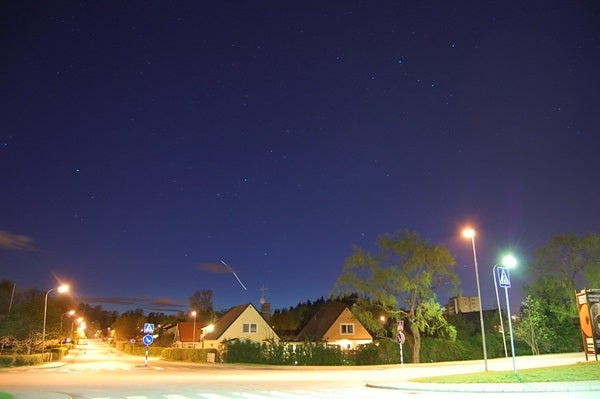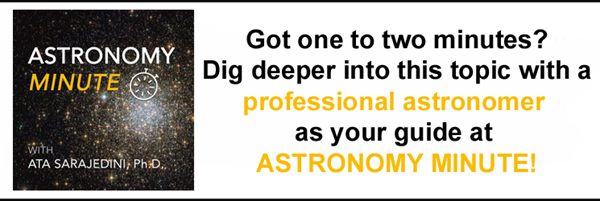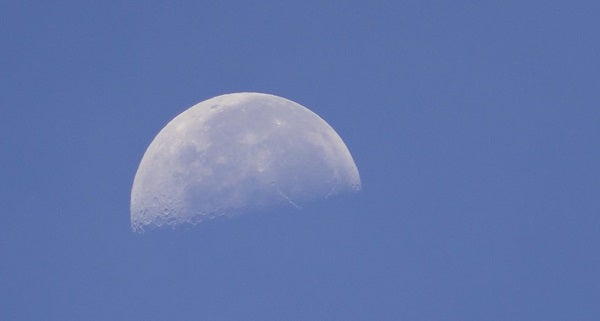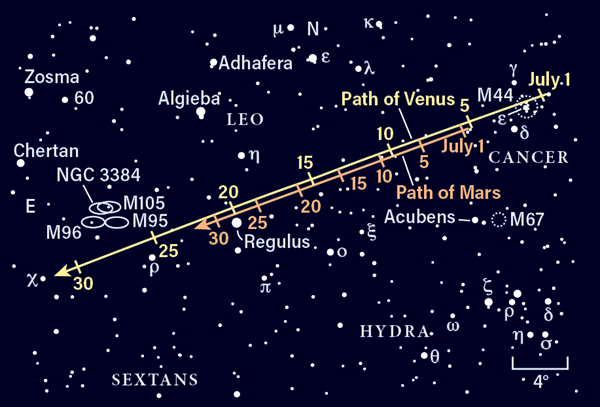Friday, June 25
As the Sun sets, Cassiopeia the Queen is starting her upward arc in the sky as she circles around Polaris, the North Star. Cassiopeia is one of several circumpolar constellations, which are close enough to the North Pole that they appear to rotate around it. From many northern locations, such constellations are always above the horizon.
Cassiopeia is easily recognizable as a W-shaped asterism in the sky. That W is facing right-side up early this evening, then slowly turns to stand on its left side by sunrise tomorrow. The stars that make up the asterism are, from left to right, Segin (Epsilon [ϵ] Cas), Ruchbah (Delta [δ] Cas), Navi (Gamma [γ] Cas), Schedar (Alpha [α] Cas), and Caph (Beta [β] Cas). Although not part of the W, Achird (Eta [η] Cas) lies just below a line connecting Gamma and Alpha, and about two-thirds of the way from the former to the latter. Achird is a beautiful binary star with a bright blue primary and a dimmer orange-red secondary, separated by 11″.
Sunrise: 5:33 A.M.
Sunset: 8:33 P.M.
Moonrise: 9:58 P.M.
Moonset: 6:10 A.M.
Moon Phase: Waning gibbous (99%)
*Times for sunrise, sunset, moonrise, and moonset are given in local time from 40° N 90° W. The Moon’s illumination is given at 12 P.M. local time from the same location.
Saturday, June 26
The early-morning Saturday sky features a close encounter between Comet 7P/Pons-Winnecke and the bright southern star Fomalhaut, alpha star of Piscis Austrinus the Southern Fish. Rising after 1:30 A.M. local time, the comet floats just 1.7° east-northeast of the bright magnitude 1.1 star.
Just two weeks past its closest approach to Earth, Pons-Winnecke is roughly magnitude 11 and will require a larger telescope of 6 inches or more to enjoy. The Moon is also in the area, which may wash out the comet’s more feeble light. Pons-Winnecke will continue traveling southeast against the background, so you can try returning to the area in a few days, when your prospects for spotting it will have improved.
If you’re looking for a brighter but still challenging target, try for Neptune, which sits north of the comet in the corner of Aquarius. Now 5.7° east-northeast of Phi (ϕ) Aquarii, Neptune is stationary against the background stars at 6 A.M. EDT. The planet, which shines at magnitude 5.8 and is within easy reach of most binoculars, is just 7′ east of a magnitude 7.2 field star. The pair might almost appear like a double star, but spend a few moments looking and you’ll likely notice Neptune’s “flatter,” more disklike appearance.
Sunrise: 5:33 A.M.
Sunset: 8:33 P.M.
Moonrise: 10:47 P.M.
Moonset: 7:19 A.M.
Moon Phase: Waning gibbous (95%)
Sunday, June 27
The Moon passes 4° south of Saturn at 5 A.M. EDT — although by that time, the sky is likely already growing bright with the coming dawn. A few hours earlier, however, you can catch the pair just over 5° apart in Capricornus the Sea Goat. By 4:30 A.M. EDT, they’re sitting due south and form a nice triangle with Deneb Algedi, Capricornus’ magnitude 2.9 delta star, about 12° to their northeast.
Zoom in on Saturn with a telescope and, despite the bright background, you’ll still be able to make out its stunning rings, which stretch nearly 42″ across. Thanks to their angle of 17°, the planet’s southern polar region is becoming visible. Although many of Saturn’s dimmer moons will likely be washed out, brighter Titan (magnitude 8.6) sits 2.7′ west of the planet and should still be visible.
Sunrise: 5:34 A.M.
Sunset: 8:33 P.M.
Moonrise: 11:27 P.M.
Moonset: 8:30 A.M.
Moon Phase: Waning gibbous (88%)
Monday, June 28
Since yesterday, the Moon has shifted east and will pass 4° south of Jupiter at 3 P.M. EDT. Early this morning around 4:30 A.M. EDT, our satellite is still nearly 9° southwest of the solar system’s largest planet.
Jupiter is located in Aquarius, nearly 12° directly below (south) of Sadalmelik, the Water-bearer’s 3rd-magnitude alpha star. At magnitude –2.6, the planet vastly outshines the constellation’s stars. All four Galilean moons sit to Jupiter’s west this morning; from east to west, you’ll see Io, Europa, Ganymede, and Callisto. They’re easy to see even with a small telescope. The planet itself spans 45″ and, just two months from opposition, is an excellent telescope target. Look for bands of color and subtler features such as spots and swirls that move quickly as the planet rotates every 10 hours or so.
Sunrise: 5:34 A.M.
Sunset: 8:33 P.M.
Moonrise: 11:59 P.M.
Moonset: 9:42 A.M.
Moon Phase: Waning gibbous (81%)
Tuesday, June 29
An hour or two after sunset, Ursa Major is balanced on her front paws and above her head is a pair of galaxies not to be missed. M81 and M82 are two relatively nearby spirals with a history — following a close pass several hundred million years ago, both galaxies underwent gravitational effects that caused them to begin forming vast quantities of stars. Today, the two appear about 35′ apart on the sky (slightly greater than the diameter of the Full Moon) and you can capture both in a low-power eyepiece or perhaps even your finder scope.
M81, also called Bode’s Galaxy after its discoverer, Johann Bode, is a tightly wound spiral galaxy. M82, also called the Cigar Galaxy, appears long and thin (like its namesake) because we are seeing it edge-on. Despite the fact that M81 is brighter, M82 is often easier to see because its light is more concentrated, meaning it has a higher surface brightness.
Sunrise: 5:34 A.M.
Sunset: 8:33 P.M.
Moonrise: —
Moonset: 10:49 A.M.
Moon Phase: Waning gibbous (71%)
Wednesday, June 30
The planet Uranus stands about 14° high two hours before sunrise. You’ll find it in the east, glowing a faint magnitude 5.9 in a sparse region of Aries the Ram. This morning, use binoculars to home in Uranus and you’ll see it’s sitting just 11′ due north of Omicron (ο) Arietis, which shines at roughly the same magnitude as the planet.
Once you’ve looked your fill, consider swinging your gaze to nearby Taurus, where the Pleiades (M45) are rising. This famous grouping of young stars is often mistaken for the Little Dipper because of its dipperlike shape — but the actual Little Dipper is much larger and lies upside-down in the north this morning, stretching outward from the end of its handle, which is marked by Polaris.
The Moon passes 4° south of Neptune at 5 A.M. EDT this morning. Before sunrise, you’ll find them in Aquarius, which sits above the southeastern horizon.
Sunrise: 5:35 A.M.
Sunset: 8:33 P.M.
Moonrise: 12:26 A.M.
Moonset: 11:54 A.M.
Moon Phase: Waning gibbous (62%)
Thursday, July 1
It’s finally time to welcome planet Mercury back into the sky. The solar system’s smallest planet will now begin appearing about an hour before sunrise, rising in the east with the horns of Taurus the Bull. Half an hour before sunrise, Mercury is a scant 7° high, glowing at magnitude 0.8. It currently hangs about 9° east-northeast of ruddy Aldebaran, the eye of the Bull. Binoculars should show the tiny planet, whose disk spans 9″; however, take care to stop observing several minutes before sunrise at your location to avoid accidentally catching our star’s glare in your optics.
Last Quarter Moon occurs at 5:11 P.M. EDT today. Over the next week and a half, our satellite will shrink as a waning crescent until it disappears at New Moon on the 9th.
Sunrise: 5:35 A.M.
Sunset: 8:33 P.M.
Moonrise: 12:51 A.M.
Moonset: 12:55 P.M.
Moon Phase: Waning gibbous (52%)
Friday, July 2
This month, there’s a race between Venus and Mars in the post-sunset sky. Over the next few weeks, you’ll see Venus overtake Mars as they skim across Cancer and end the month within the bounds of Leo the Lion.
Tonight, brilliant Venus (magnitude –3.9) lies within the northern regions of the stunning Beehive Cluster in the center of Cancer, also known as Praesepe and M44. There is a bit of time to enjoy the sight before they set around 10 P.M. local time, and binoculars or any small scope should net you a great view, especially if you’ve got a clear, dark western horizon. Astrophotographers will especially want to capture the scene.
Just over 6° east of Venus sits Mars, glowing at a fainter magnitude 1.8. The Red Planet spans roughly 4″ — a small but still rewarding target in binoculars or a telescope.
Sunrise: 5:36 A.M.
Sunset: 8:32 P.M.
Moonrise: 1:14 A.M.
Moonset: 1:55 P.M.
Moon Phase: Waning crescent (42%)













